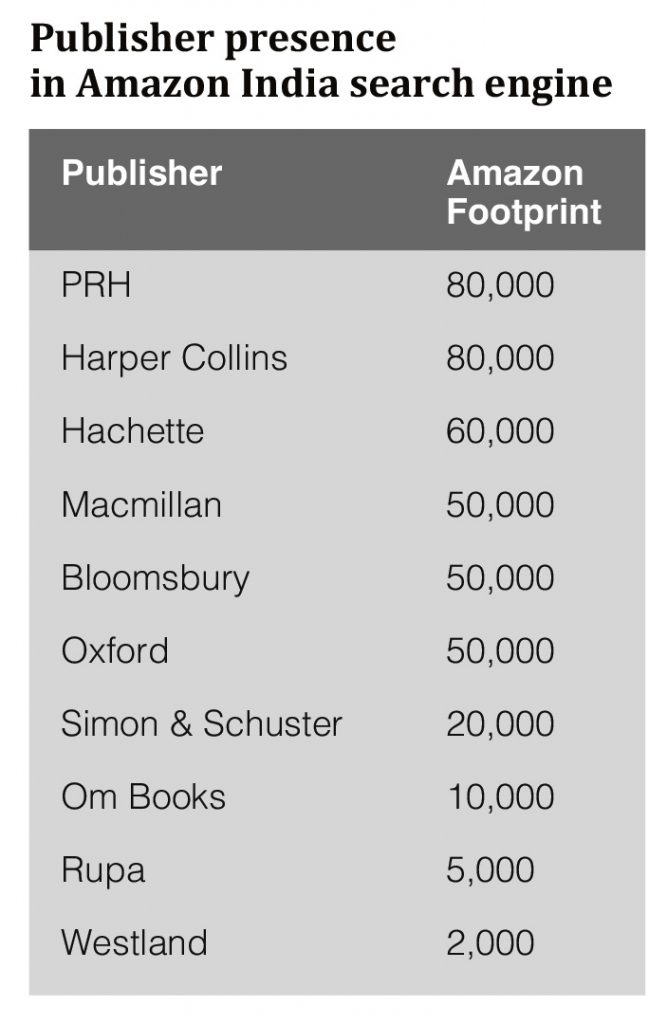Soon after the Corona pandemic, in July 2020, Tata Consumer Products terminated long term contracts with 40 nationwide distributors and 5,000 dealers of Tata Salt, Tata Tea, Himalayan Water and other brands to pursue the digitally empowered direct dealership strategy that has been the strength of rival multinationals like Unilever, Nestle and P&G. Tata Consumer Products will adopt a leaner digitally integrated marketing strategy and expand its footprint to the US, Canada and the UK, confirmed Tata Group chairman N Chandrashekhar during its virtual AGM.
A year back, many book publishers in India were confident that retail bookstore sales would deliver most of their revenues and profits. They did not push hard for digital sales. The reason was simple. Over the last decade, digital platforms like Amazon and Flipkart have immensely strengthened their reach and revenues, while booksellers and publishers have had to do with lower margins.
Hence, many Indian publishers decided to go slow on digital distribution and protect their turf from the digital giants. But the Covid-19 global pandemic and the lengthy lockdown that followed have now created serious doubts about the ‘physical book store alone’ strategy. Having been associated with the publishing industry and the digital media platforms of Delhi Press and Indian Express during the last decade, I decided to dive into how book publishers in India were doing without their own digital platforms leading to ‘over-dependence’ on Amazon.
Is Kindle Unlimited fruitful for authors and publishers?
Most publishers do not have a well developed in-house eBook platform, and many have accepted the Kindle eBook platform — a profitable proposition before 2014. At that time, Kindle Direct Publishing KDP set up a unique eBook library from which every Kindle owner could download one book per month for free. Amazon initially provided the Kindle library funding of US$ 1 million each month to compensate the authors and publishers proportionally for the free library downloads. At that time, a publisher was paid US$ 2.1 if an eBook of 150 pages sold for US$ 3 under the 70:30 formula. In the unlikely event of a book being downloaded under the Kindle Owners Lending Library program every month, the publisher would be paid out of the KU fund for the book once the reader had read 10% of the book.
The formula was tweaked in 2014, 2015, 2016, 2018, and 2019 by Amazon so that it is no longer profitable for publishers and authors despite Amazon raising the KU fund pool to US$ 25 million a month. “We get 70% of sales proceeds now only if we agree to join the Kindle Unlimited library. Else we have to do with 35% margin,” says a publisher. “Also, Amazon increases the Kindle discounts automatically to ensure that the eBook is always priced lower than the lowest price print book available on the net. It isn’t very easy to predict what we will earn with Kindle. All I can say is that it is pretty insignificant. There are other reasons for worry too. The Kindle Unlimited download produces high print quality PDFs, which leaves the room open for piracy. We suspect that books on KU witness more piracy,” admitted the publisher.
Amazon varies it’s subscription rates regularly to entice readers. In June 2019, it unleashed a 2-month subscription offer for just Rs 59/- in India. But even without special offers, it is very cheap for the reader. This because customers of Kindle Unlimited (KU) currently paying a subscription of Rs 1800 annually are permitted unlimited downloads with a maximum of 10 downloads at a time in any month. It is virtually a family package deal at an affordable rate of Rs 150/- per month. The deal is highly profitable for both Amazon and the reader, but it is a losing proposition for the author and the publisher.
Without delving into the complicated math of multiple versions of the Kindle Edition Normalized Page Count KENPC system of payment, I will simply say that as per the July 2019 rates when the KU reader reads a 150 pages eBook, the publisher now receives around 33 paise (US$ 0.0044 ) per page read with a maximum payout of Rs 56 (US$ 0.75). In short, the author or the publisher of a 150 page eBook today can earn only a third of what she could through Kindle in 2014, but only after the reader has downloaded and read the full book, not just 10% of the book as previously. By offering such a favorable deal to the reader who would not have to pay full value on purchase or download, but on 100% reading of the book, the KU subscription soared in the five years by a hundredfold. It meant substantial advertisement revenues for Amazon that need not be shared with the author or publishers. The opportunity cost of joining Kindle Unlimited is enormous, as publishers admit significant fall in physical sales, but the real costs have still not been calculated by analysts. Publishers are bleeding, but do not dare to ditch Kindle because, coincidentally, every book in the NYT bestseller list is at the top of the Kindle Bestseller list. It is still anybody’s guess whether NYT follows KU or vice-versa.
Amazon and Flipkart are great platforms if you use them well
Every successful product in India uses digital discovery and distribution platforms like Amazon and Flipkart. But they use their marketing arms to boost sales. Both Cadbury and Nestle have a whole range of bouquet offers for Amazon, Flipkart, Big Bazar, and Reliance Retail and mom and pop stores. They also define their own marketing strategies without digital platforms dictating the terms. Similarly, Sunsilk, Pantene, and Garnier compete in physical and digital markets based on their marketing strategies using a dozen platforms, including Amazon, Flipkart, Television, consumer websites, direct marketing, blogs, and multiple social media forums.
Book publishers do it differently. Those publishers relying on Amazon or Flipkart for sales have cut down on their own marketing and promotion efforts for some reason. There is another flock of publishers who try to do the marketing themselves but without a reasonable footprint on Amazon or Flipkart. Both strategies are incorrect as they do not optimize the marketing resources available for maximum impact at the lowest cost.

The combined cost of digital and physical marketing is lower than the cost of physical marketing with a better return on investment (ROI). A recent McKinsey report on performance branding states, “companies report marketing efficiency gains of up to 30% and incremental top-line growth of up to 10% without increasing the marketing budget.” Yet Indian book publishers have been reluctant to effectively use the available digital platforms, unlike big multinational brands. The table below shows the footfall of publishers on the Amazon platform against publisher search. It shows how multinational publishers are far ahead in the use of the digital platform. The results are even worse on Flipkart. It shows the underutilization of existing resources by Indian publishers. Also, their websites and social media pages are low traffic sites. This is the reason why the pandemic has hit the Indian publishers harder than the big 5. Unlike most Indian publishers, the multinationals are back in business, with plans of full production runs this quarter, before the textbook printing season starts in October 2020.
“Amazon is a great platform to use if you can build the profile of each book and its journey,” says a former head of marketing of a multinational publishing house. “It is an effort that needs regular tweaking and updating and hence both time and application, but one that pays off handsomely in the long run. It is a low hanging fruit but one that people mostly miss out on.” When I asked him about the sales push that deep discounts offered, he quickly refuted the claim saying, “There is no evidence to suggest that deep discounts help boost book sales because the price of books in India is already so low.”
Most people do not understand that Amazon is purely a platform, and like any device, you have to know how to use it to your best advantage, he explained. “We book publishers, unfortunately, either treat it as God or the Devil, and that is where we make a mistake. Amazon is just your digital dealer, and you, as a publisher, must help the books sell off the Amazon platform like in any book store.” Another publisher says the deep discounts are usually offered by distributors wanting to offload stocks, and that could even go up to 40% to 50% with ‘deal of the day’ offers at Amazon. Amazon should cap discounts like Flipkart but does not do so.
Using Search Engine Optimisation for the digital visibility of a book
Understanding how Google works is essential for creating an effective digital sales strategy. While Amazon is the distributor and dealer, Google search is the most popular way that digital readers seek information. So you have to create an active digital buzz for each book and each author that you publish. It is a minimal cost to pay, much less than the amounts publishers have to shell out for premium space at a large book store chain. Yet publishers miss out on promoting a book through small feeds on the web and updating and tweaking the search engine optimization inputs regularly. Understanding SEO is not a tech complexity like coding, and the marketing team of the publishers needs to train themselves with SEO skills for effective digital marketing. Working with the authors, they can create a strong SEO link building strategy that effectively pushes a book up in Google search.
To develop such a strategy, publishers need to understand how keywords are critical in any digital conversation on the web. Again, this is not a tech complexity because every person uses those words repeatedly while doing a google search. But it needs effort and application by the marketing team to link the keywords with the book using the book’s content to make productive conversations on the web. Unfortunately, publishers have been lazy in SEO promotion and creating an effective keyword strategy for every book and author.
Google tweaks its model regularly to avoid spamming by robots, so the marketing team needs to keep itself updated on the techniques it employs to entice the Google web spiders. Understanding and learning how to climb the Google search engine is part of the process that Indian publishers have yet to master. No wonder they have a very faint footprint with Google analytics and are not significant players if we check Alexa or Similar Web traffic sites. There are many other things like social media strategy, video strategy and community building strategy that book publishers fail to leverage effectively. Those issues are secondary — to be looked at after these basics issues are tackled in the first stage of digital transformation.















